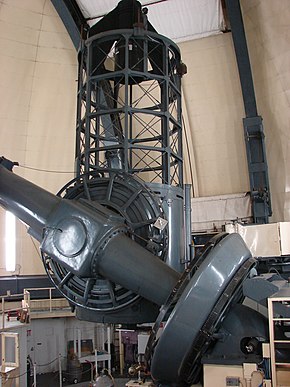 The Otto Struve Telescope The Otto Struve Telescope | |
| Alternative names | 2.1m-Otto Struve Telescope |
|---|---|
| Part of | McDonald Observatory |
| Location(s) | Jeff Davis County, Texas |
| Coordinates | 30°40′47″N 104°01′29″W / 30.679709°N 104.024823°W / 30.679709; -104.024823 |
| Built | 1933–1939 (1933–1939) |
| Discovered | Nereid |
| Telescope style | optical telescope |
| Diameter | 82 in (2.1 m) |
| Website | mcdonaldobservatory |
 | |
| [REDACTED] Related media on Commons | |
| [edit on Wikidata] | |

The Otto Struve Telescope was the first major telescope to be built at McDonald Observatory. Located in the Davis Mountains in West Texas, the Otto Struve Telescope was designed by Warner & Swasey Company and constructed between 1933 and 1939 by the Paterson-Leitch Company. Its 82-inch (2.1 m) mirror was the second largest in the world at the time. It was named after the Ukrainian-American astronomer of Baltic German origin Otto Struve in 1966, three years after his death; Struve had been the director of McDonald Observatory from 1932–1950.
The Davis Mountains is an excellent location for astronomical research because of the clear dry air and moderately high elevation. The remote nature of the facility proved to be a significant challenge in transporting such a large mirror. It was a very precarious journey for the Otto Struve Telescope's mirror to this remote part of Texas and up to the top of Mount Locke. The mirror was transported from the local town of Fort Davis up the mountain by Carleton D. Wilson, owner of a local trucking company, while locals cheered as they looked on.
The Otto Struve telescope is still in use today. It is updated with modern imaging detectors allowing astronomers to conduct many types of research.
Noted applications and Discoveries
The telescope was one of two used to set up and define the Johnson-Morgan UBV photometric system.
In 1949, G. Kuiper of Yerkes Observatory discovered a new moon of planet Neptune, named Nereid. The moon was discovered on photographic plates taken in a search for moons of Neptune.
Contemporaries on commissioning
The Otto Struve telescope saw first light in 1939, behind the 100-inch Hooker telescope and ahead of two large British Commonwealth telescopes, both in Canada. Many competing projects were delayed due to the war in the early 1940s.
Four largest telescopes in 1939:
| # | Name / observatory | Image | Aperture | Altitude | First light | Special advocate |
|---|---|---|---|---|---|---|
| 1 | Hooker Telescope Mount Wilson Obs. |
100 inch 254 cm |
1742 m (5715 ft) |
1917 | George Ellery Hale Andrew Carnegie | |
| 2 | Otto Struve Telescope McDonald Obs. |
82 inch 208 cm |
2070 m (6791 ft) |
1939 | Otto Struve | |
| 3 | David Dunlap Observatory | 74 inch 188 cm |
224 m (735 ft) |
1935 | Clarence Chant | |
| 4 | Plaskett telescope Dominion Astrophysical Obs. |
72 inch 182 cm |
230 m (755 ft) |
1918 | John S. Plaskett |
See also
- List of largest optical telescopes in the 20th century
- List of largest optical reflecting telescopes
- List of the largest optical telescopes in the contiguous United States
Notes
- It was second only to the Mt. Wilson 100-inch (2.5 m) telescope.
References
- The Film & Video Archive of the McDonald Observatory. "Telescope Mirror and Dedication Rodeo (1939)". Texas Archive of the Moving Image.
- ^ Kuiper, G. P. (August 1949). "The Second Satellite of Neptune". Publications of the Astronomical Society of the Pacific. 61 (361): 175–176. Bibcode:1949PASP...61..175K. doi:10.1086/126166.
External links
- "Pour Three Ton Telescope Mirror." Popular Science, April 1934, p. 41.
- Science: The 82-Inch McDonald Telescope (1939), industrial film capturing the construction and design of the Otto Struve Telescope, Texas Archive of the Moving Image.